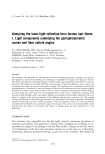SC WATER-HANDLING PROPERTIES 295 Table VI Statistical Analysis of Effects of Skin Treatments on Instrumental Measurements TEWL 30 min after MAT 30 min after TEWL MAT NMF application NMF application after 4 hr after 4 hr Treatment Acetone/ether •' ND •' ND Water soak A/E + water soak Effect of NMF Untreated + NMF ,[, •' ,[, ND A/E + NMF $ • $ NO Soak + NMF ,[, •' ,[, $ (d) A/E + soak + NMF The effects of the A/E extraction, water soak, and NMF treatment for the respective sites on barrier integrity (TEWL) and SC water-handling properties (MAT) were determined relative to the initial skin condition. The changes and associated statistical significance are shown. •' indicates a significant increase (p • 0.05), ,• indicates a significant decrease, ND indicates no significant difference, and (d) is a difference atp • 0.07. Soak Water Soak ] • , ,• Untreate -1 1 1 -1 Soak + NMF -2 -3 Figure 1. The changes from baseline skin condition in TEWL versus MAT are shown for one of the sites. The site was first soaked in water and then treated with an NMF formulation. The measurements were made 30 minutes after application. The numerical values shown in the figure have been normalized for changes in the parallel untreated control site. decrease in TEWL for the extracted-plus-soaked site were maintained four hours later (Table VI). Direct comparison of the NMF treatments with the corresponding vehicle controls indicated that the decreases in TEWL were due to the NMF components and not to the vehicle itself (Table VI). Application of NMF produced a significantly higher MAT for all four skin conditions at thirty minutes following treatment (Table VI). The MAT increase was maintained four hours later for the A/E-extraction-plus-water-soak site only. The changes in MAT following NMF treatment were not attributable to the vehicle. The addition of NMF to the skin resulted in a significant increase in baseline hydration
296 JOURNAL OF COSMETIC SCIENCE for the untreated and the A/E-extracted-plus-water-soaked sites at thirty minutes (Table V). For the soaked site, NMF application increased hydration directionally (p = 0.07). NMF addition had no effect on the A/E-extracted site. DISCUSSION The human stratum corneum is a thin, flexible, mechanically tough membrane that is essential for cutaneous protection against environmental insults and loss of body water in a dry, terrestrial environment. The SC barrier properties are conferred by intercellular lipids arranged as lameliar sheets surrounding corneocytes tightly linked by desmosomal connections (22-24). The flexibility and water-holding properties of the SC are, in large part, attributable to hygroscopic, water-soluble compounds, collectively known as NMF (15,25). The primary constituents are high concentrations of amino acids, including derivatives such as pyrrolidone carboxylic acid and urocanic acid, that are found in the stratum corneum (26,27). NMF is generated in part by proteolysis of the SC protein filaggrin, which occurs under conditions of optimal water activity, i.e., in a relative humidity range of 70% to 95% (2). Interference with either the composition or structure of the lameliar lipids or the production or accumulation of NMF can, presumably, disturb the water balance of the stratum corneum. Disruption of the intercellular lamellae can occur as a result of treatment with solvents and with water itself (12,28). In this study, we examined the effects of a common perturbation, exposure to water via soaking, on the SC permeability barrier and water-handling properties. We used a solvent system to extract the hydro- phobic surface residue and SC lipids from the upper layers. Acetone/ether extraction has been shown to remove lipids without removing the water-soluble components (13). Extraction of the intercellular SC lipids was expected to increase access to the soluble components within the upper stratum corneum during the soaking phase. We antici- pated that the combination of solvent extraction (barrier damage) followed by water exposure would model the effects of surfactant-water interactions with the SC and determine the relative contributions of changes in lipids and changes arising from removal of water-soluble materials. To test the hypothesis that water-soluble compo- nents significantly impact SC water-handling properties, we applied an NMF compo- sition back to soaked or extracted skin sites and evaluated the water-handling properties using measurements of TEWL and hydration. Acetone/ether extraction significantly increased TEWL for five hours (Table VI), sug- gesting that recovery from lipid depletion was not immediate. The finding that solvent treatment did not significantly change MAT is consistent with reports that very small amounts of water-soluble components are removed with acetone/ether extraction (21). The MAT methodology has been used as a surrogate for TEWL in animal models (29,30) and cell culture systems (29), and for assessing the development of barrier function in premature human infants (31). In situations of extreme barrier compromise, e.g., tape stripping or premature birth, increased MAT paralleled an increase in TEWL (31,32). Decreased MAT has been observed to indicate barrier development or recovery (29,30,32). In this study, barrier compromise by A/E extraction, while producing a statistically significant increase in TEWL, was small and did not significantly alter MAT. We have observed that MAT decreases in dry scaly skin (e.g., due to low relative
Purchased for the exclusive use of nofirst nolast (unknown) From: SCC Media Library & Resource Center (library.scconline.org)


























































































